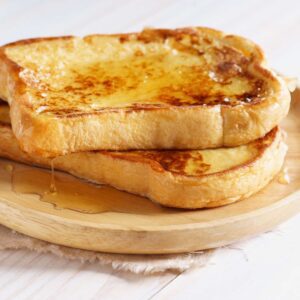Introduction to French Toast
French toast, also known as eggy bread, Gypsy toast, and pain perdu in various parts of the world, is a beloved breakfast dish enjoyed by many for its sweet, custardy center and crispy edges. This classic breakfast favorite is made by soaking slices of bread in a mixture of beaten eggs, milk, and often a hint of sweetness or spice, then frying them until golden brown. Typically served warm, it’s commonly topped with maple syrup, powdered sugar, fresh fruit, or even whipped cream, making it as versatile as it is delicious.

History of French Meditation on French Toast
The origin of French toast can be traced far back, well beyond its popular association with France, to the Roman Empire. The earliest reference to a dish similar to French tounderstands can be found in the Apicius, a collection of Latin recipes dating back to the 4th or 5th century. This collection describes “Aliter Dulcia” (another sweet dish) where bread was soaked in milk and beaten egg, then fried in oil or butter, showcasing how ancient the concept of French toast is.
Ingredients
- Essentials for a classic French toast:
- Bread: Thick slices like brioche or challah are preferred for their ability to soak up the egg mixture without falling apart.
- Eggs: Acts as the binding agent.
- Milk: Whole milk or cream for a rich flavor.
- Sugar: For a touch of sweetness.
- Cinnamon: Adds a warm flavor.
- Vanilla Extract: Enhances the overall aroma.
- Optional ingredients for flavor variations:
- Fresh fruits, nuts, and syrups for topping.
- Spices such as nutmeg or cardamom for a distinctive taste.
Essential Cooking Tools
- Key tools needed to make French toast:
- Non-stick Skillet or Griddle: Ensures
The Recipe and Advanced Tips
Step-by-Step French Toast Cooking Guide
- Preparing the Egg Mixture:
- In a deep plate or bowl, whisk together eggs, milk, cinnamon, sugar, and vanilla extract until well combined.
- Ensure the mixture is smooth for even coating.
- Preparing the Bread:
- Choose thick slices of bread such as brioche or challah to prevent them from breaking when soaked.
- If using fresher bread, lightly toast it to enhance its ability to hold the mixture without getting soggy.
- Dipping and Soaking:
- Dip each slice of bread into the egg mixture, allowing it to soak for about 30 seconds on each side.
- Be careful not to oversoak, which can make the bread too soggy.
- Cooking:
- Heat a non-stick skillet or griddle over medium heat and add a little butter or oil.
- Place the soaked bread slices onto the skillet and cook until golden brown, typically 2-4 minutes per side.
- Ensure each side is cooked to a golden-brown color for optimal taste and texture.
- Serving Suggestions:
- Serve hot, ideally right off the skillet.
- Top with powdered sugar, maple syrup, fresh berries, or a dollop of whipped cream to enhance the flavor.
- Consider savory variations by topping with bacon or drizzling with honey.
Secret Tips from Professional Chefs
- Ingredient Choices:
- Professional chefs prefer using day-old bread as it absorbs the egg mixture well without falling apart.
- Experiment with milk alternatives like almond or coconut milk for a different flavor twist.
- Flavor Enhancers:
- Infuse the milk mixture with citrus zest (orange or lemon) before adding it to the eggs for a subtle freshness.
- Introduce spices such as cardamom or allspice to the cinnamon in the egg mixture for a unique taste.
- Perfect Cooking Technique:
- Cook on a medium-low heat to avoid burning the exterior while ensuring the inside is well-cooked.
- Use real butter for frying as it gives the French toast a rich flavor and golden crust.
Troubleshooting Common Mistakes
- Avoiding Sogginess:
- Avoid excessive dipping time. Swift, comprehensive coating of the bread is sufficient.
- Use thicker bread
Frequently Asked Questions (FAQs) about French Toast
What is the best type of bread to use for French toast?
The best breads for French toast are typically denser and slightly drier varieties like brioche, challah, or thick-cut Texas toast. These types of bread soak up the egg mixture well without becoming too soggy.
Can French toast be made in advance?
While French toast is best enjoyed fresh, you can prepare the egg-soaked bread slices ahead of time and refrigerate them overnight. Cook them in the morning for a quick breakfast. For best results, it’s recommended to cook French toast right before serving.
How can I make French toast without milk?
If you need to avoid milk, you can use alternatives such as almond milk, coconut milk, or oat milk. These will still create a delicious and creamy batter for your French toast without using dairy milk.
Is it necessary to use cinnamon and vanilla in French toast?
While not strictly necessary, cinnamon and vanilla are classic flavor enhancers in the traditional French toast recipe. They add depth and warmth to the dish. However, you can omit these or substitute other flavors according to taste preferences, such as nutmeg
